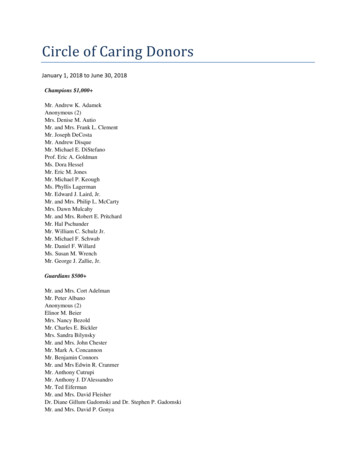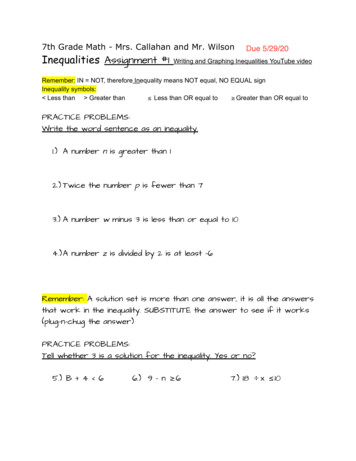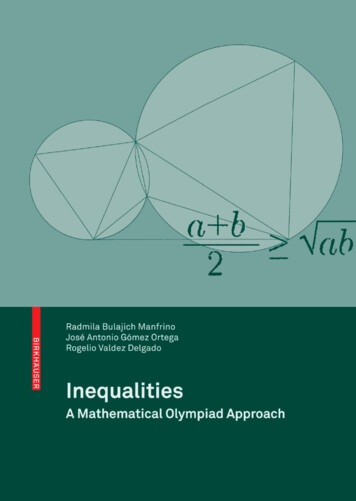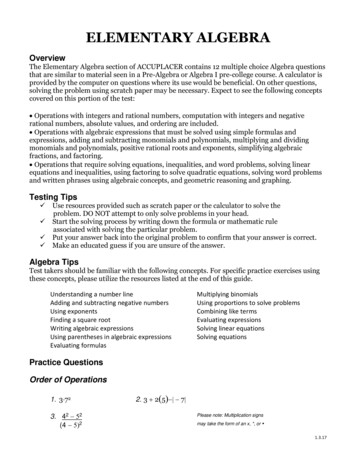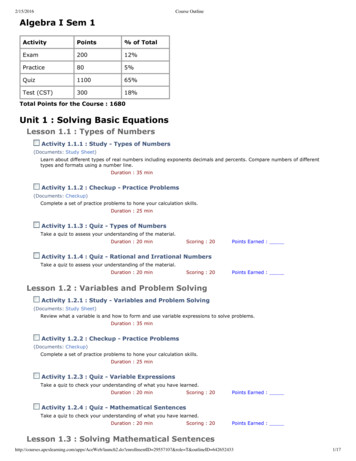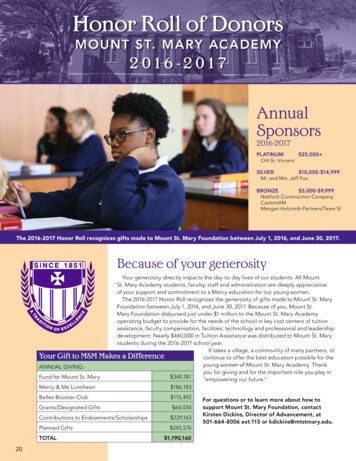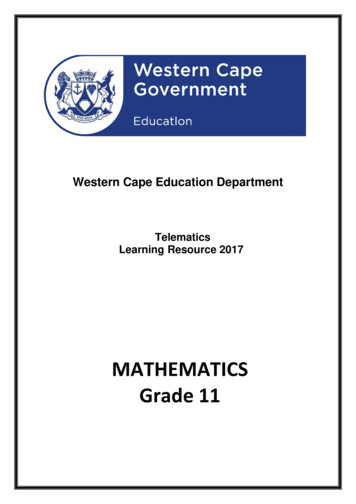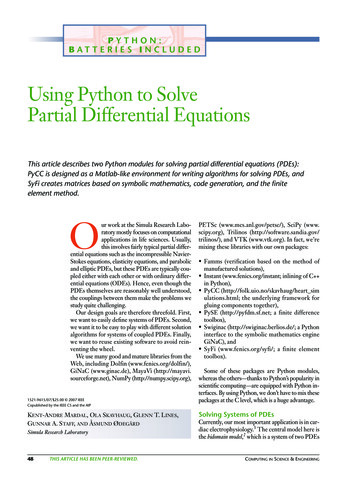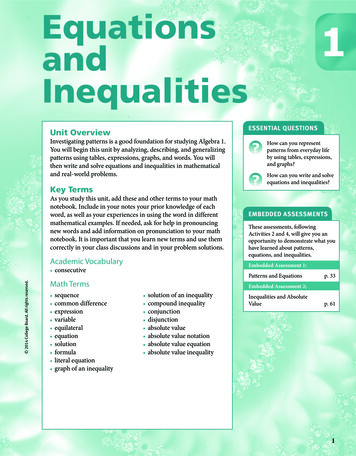
Transcription
EquationsandInequalitiesESSENTIAL QUESTIONSUnit OverviewInvestigating patterns is a good foundation for studying Algebra 1.You will begin this unit by analyzing, describing, and generalizingpatterns using tables, expressions, graphs, and words. You willthen write and solve equations and inequalities in mathematicaland real-world problems.Key TermsAs you study this unit, add these and other terms to your mathnotebook. Include in your notes your prior knowledge of eachword, as well as your experiences in using the word in differentmathematical examples. If needed, ask for help in pronouncingnew words and add information on pronunciation to your mathnotebook. It is important that you learn new terms and use themcorrectly in your class discussions and in your problem solutions. 2014 College Board. All rights reserved.Academic Vocabulary consecutiveMath Terms sequence common difference expression variable equilateral equation solution formula literal equation graph of an inequality1How can you representpatterns from everyday lifeby using tables, expressions,and graphs?How can you write and solveequations and inequalities?EMBEDDED ASSESSMENTSThese assessments, followingActivities 2 and 4, will give you anopportunity to demonstrate what youhave learned about patterns,equations, and inequalities.Embedded Assessment 1:Patterns and Equationsp. 33Embedded Assessment 2: solution of an inequality compound inequality conjunction disjunction absolute value absolute value notation absolute value equation absolute value inequalityInequalities and AbsoluteValuep. 611
UNIT 1Getting ReadyWrite your answers on notebook paper.Show your work.1. What is 2 4 ?3 52. What condition must be met before you canadd or subtract fractions?3. Jennifer is checking Megan’s homework. Theydisagree on the answer to this problem: 42 22.Jennifer says the product is 32 and Megan saysit is 64. Who has the correct answer? Explainhow she arrived at that correct product.4. A piece of lumber 2 1 feet long is to be cut into43 equal pieces. How long will each piece of cutwood be? Give the measurement in feet andin inches.5. Arrange the following expressions in order oftheir value from least to greatest.a. 4 6b. 4 6c. 4 66. Which expression has the greater value? Justifyyour answer.A. 8 3B. 8 310. The Venn diagram below provides a visualrepresentation of the students in Mr. Griffin’sclass who participate in music programs afterschool. What does the diagram tell you aboutthe musical involvement of Student B andStudent G? Explain how you reached yourconclusion.Students whoplay pianoStudents inthe bandCABFDEG 2014 College Board. All rights reserved.7. Which of the following are equal to 14.95?A. 2.3 6.5B. 21.45 6.5C. 8.32 6.638. Which equation has the least solution?A. x 5 13B. 6x 30C. x 18D. x 2 1149. Combine like terms in the followingexpressions.a. 10x 4xb. 15n 3nc. 7.5y 1.6y 2 d. m 4 2m2SpringBoard Mathematics Algebra 1, Unit 1 Equations and Inequalities
Investigating PatternsACTIVITY 1Cross-Country AdventuresLesson 1-1 Numeric and Graphic Representations of DataMy NotesLearning Targets: Identify patterns in data. Use tables, graphs, and expressions to model situations. Use expressions to make predictions.SUGGESTED LEARNING STRATEGIES: Sharing and Responding,Create Representations, Discussion Groups, Look for a Pattern,Interactive Word WallMizing spent his summer vacation traveling cross-country with his family.Their first stop was Yellowstone National Park in Wyoming and Montana.Yellowstone is famous for its geysers, especially one commonly referred to asOld Faithful. A geyser is a spring that erupts intermittently, forcing afountain of water and steam from a hole in the ground. Old Faithful can haveparticularly long and fairly predictable eruptions. As a matter of fact, parkrangers have observed the geyser over many years and have developedpatterns they use to predict the timing of the next eruption.Park rangers have recorded the information in the table below.Length of Eruption(in minutes)1234Yellowstone National Park wasthe first National Park. The parkwas established by Congresson March 1, 1872. PresidentWoodrow Wilson signed theact creating the National ParkService on August 25, 1916.Approximate TimeUntil Next Eruption(in minutes)465870821. Describe any patterns you see in the table. 2014 College Board. All rights reserved.CONNECT TO HISTORY2. Why might it be important for park rangers to be able to predict thetiming of Old Faithful’s eruptions?DISCUSSION GROUP TIPSWork with your peers to set rulesfor: discussions and decision-making clear goals and deadlines individual roles as needed3. If an eruption lasts 8 minutes, about how long must park visitors wait tosee the next eruption? Explain your reasoning using the patterns youidentified in the table.Activity 1 Investigating Patterns3
Lesson 1-1Numeric and Graphic Representations of DataACTIVITY 1continuedMy Notes4. Graph the data from the table on the grid below.Approximate time until nexteruption (in minutes)1401201008060402012 3 4 5 6 7 8 9Length of eruption (in minutes)105. Reason quantitatively. Mizing and his family arrived at Old Faithfulto find a sign indicating they had just missed an eruption and that itwould be approximately 2 hours before the next one. How longwas the eruption they missed? Explain how you determined your answer.A sequence is a list of numbers,and each number is called a termof the sequence. For example:2, 4, 6, 8, and 2, 5, 10, 17, aresequences.Patterns can be written as sequences.6. Using the table or graph above, write the approximate times until thenext Old Faithful eruption as a sequence.7. How would you describe this sequence of numbers?4 SpringBoard Mathematics Algebra 1, Unit 1 Equations and Inequalities 2014 College Board. All rights reserved.MATH TERMS
Lesson 1-1Numeric and Graphic Representations of DataIn the table below, 5 and 8 are consecutive terms. Some sequences havea common difference between consecutive terms. The common differencebetween the terms in the table below is 3.Sequence: 5, 8, 11, 14 Term numberTerm1234581114ACTIVITY 1continuedMy NotesACADEMIC VOCABULARYConsecutive refers to items thatfollow each other in order.MATH TIPA common difference is also calleda constant difference.8. Identify two consecutive terms in the sequence of next eruption timesthat you created in Item 6.9. The sequence of next eruption times has a common difference. Identifythe common difference. 2014 College Board. All rights reserved.10. Each term in the sequence above can be written using the first term andrepeated addition of the common difference. For example, the first termis 5, the second term is 5 3, and the third term can be expressed as5 3 3 or 5 2(3). Similarly, the terms in the sequence of nexteruption times can also be written using repeated addition of thecommon difference.a. Write the approximate waiting time for the next eruption aftereruptions lasting 4 and 5 minutes using repeated addition of thecommon difference.b. Model with mathematics. Let n represent the number of minutesan eruption lasts. Write an expression using the variable n thatcould be used to determine the waiting time until the next eruption.c. Check the accuracy of your expression by evaluating it when n 2.MATH TERMSAn expression may consist ofnumbers, variables, and operations.A variable is a letter or symbolused to represent an unknownquantity.d. Use your expression to determine the number of minutes a visitor tothe park must wait to see another eruption of Old Faithful after a12-minute eruption.Activity 1 Investigating Patterns5
Lesson 1-1Numeric and Graphic Representations of DataACTIVITY 1continuedMy NotesCheck Your UnderstandingSB-Mobile charges 20 for each gigabyte of data used on any of itssmartphone plans.11. Copy and complete the table showing the charges for data based onthe number of gigabytes used.Number ofGigabytes Used12345Total DataCharge12. Graph the data from the table. Be sure to label your axes.13. Write a sequence to represent the total price of a data plan.14. The sequence you wrote in Item 13 has a common difference. Identifythe common difference.15. Let n represent the number of gigabytes used. Write an expression thatcan be used to determine the total data charge for the phone plan. 2014 College Board. All rights reserved.16. Use your expression to calculate the total data charge if 10 gigabytes ofdata are used.6 SpringBoard Mathematics Algebra 1, Unit 1 Equations and Inequalities
Lesson 1-1Numeric and Graphic Representations of DataACTIVITY 1continuedMy NotesLESSON 1–1 PRACTICETravis owns stock in the SBO Company. After the first year of ownership thestock is worth 45 per share. Travis estimates that the value of a share willincrease by 2.80 per year.17. Copy and complete the table showing the value of the stock over thecourse of several years.YearShare Value12345 4518. Write a sequence to show the increase in the stock value over the courseof several years.19. Make use of structure. The sequence you wrote in Item 18 has acommon difference. Identify the common difference.20. Let n represent the number of years that have passed. Write anexpression that can be used to determine the value of one share ofSBO stock. 2014 College Board. All rights reserved.21. Use your expression to calculate the value of one share of stock after20 years.Activity 1 Investigating Patterns7
Lesson 1-2Writing ExpressionsACTIVITY 1continuedMy NotesLearning Targets: Use patterns to write expressions. Use tables, graphs, and expressions to model situations.SUGGESTED LEARNING STRATEGIES: Look for a Pattern, CreateRepresentations, Think-Pair-Share, Discussion Groups, Sharing andRespondingMesa Verde National Park wascreated by President TheodoreRoosevelt in 1906 as the firstNational Park designated topreserve “the works of man.” Thepark protects nearly 5000 knownarcheological sites and 600 cliffdwellings, offering a look into thelives of the ancestral Pueblopeople who lived there from600–1300 AD.Mizing and his family also visited Mesa Verde National Park in Colorado. AsMizing investigated the artifacts on display from the ancestral Pueblo peoplewho once called the area home, Mizing began to notice that the patterns usedto decorate pottery, baskets, and textiles were geometric.Mizing found a pattern similar to the one below particularly interesting.1. Reason abstractly. Draw the next two figures in the pattern.2. Create a table showing the relationship between the figure number andthe number of small squares in each figure.Figure Number Number of Squares8SpringBoard Mathematics Algebra 1, Unit 1 Equations and Inequalities 2014 College Board. All rights reserved.CONNECT TO HISTORY
Lesson 1-2Writing ExpressionsACTIVITY 1continued3. Use the variable n to represent the figure number. Write an expressionthat could be used to determine the number of small squares in anyfigure number.My Notes4. Use your expression to determine the number of small squares in the12th figure.Mizing noticed that many times the centers of the figures in the pattern werefilled in with small squares of the same size as the outer squares but in adifferent color.5. Fill in the centers of the diagrams with small colored squares. 2014 College Board. All rights reserved.6. Draw the next two figures in the pattern. Be sure to include the innercolored squares.7. Copy the first two columns of the table you created in Item 2 and add acolumn to show the relationship between the figure number and thenumber of inner colored squares.Figure NumberNumber of Number of InnerOuter Squares Colored SquaresActivity 1 Investigating Patterns9
Lesson 1-2Writing ExpressionsACTIVITY 1continuedMy Notes8. Describe any numerical patterns you see in the table.9. Write the numbers of inner colored squares as a sequence.10. Does the sequence of numbers of inner colored squares have a commondifference? If so, identify it. If not, explain.11. Model with mathematics. Graph the data from the table on theappropriate grid. Be sure to label an appropriate scale on the y-axis.a.1 2 3 4 5 6 7 8 9Figure NumberxyNumber ofInner Colored Squaresb.1 2 3 4 5 6 7 8 9Figure Number10SpringBoard Mathematics Algebra 1, Unit 1 Equations and Inequalitiesx 2014 College Board. All rights reserved.Number of Outer Squaresy
Lesson 1-2Writing ExpressionsACTIVITY 1continuedMy Notes12. Compare the graphs.13. Reason quantitatively. Use the patterns you have described topredict the number of inner colored squares in the 10th figure ofthe pattern.14. How is the number of inner squares related to the figure number?15. Use the variable n to represent the figure number. Write an expressionthat could be used to determine the number of inner colored squares inany figure number. 2014 College Board. All rights reserved.16. Use your expression to determine the number of inner colored squaresin the 17th figure.Mizing discovered another pattern in the artifacts. He noticed that whentriangles were used, the triangles were all equilateral and often multicolored.MATH TERMSIn an equilateral triangle, all threesides have the same measure.Figure 1Figure 2Figure 317. Attend to precision. Determine the perimeter of each figure in thepattern if each side of one triangle measures 1 cm.Activity 1 Investigating Patterns11
Lesson 1-2Writing ExpressionsACTIVITY 1continuedMy Notes18. Mizing found that he could determine the perimeter of any figure in thepattern using the expression 2n 1. Use Mizing’s expression to calculatethe perimeters of the next three figures in the pattern. Use the tablebelow to record your calculations.Figure Number Perimeter (cm)20. Represent the relationship between the figures in the pattern and theirperimeters as a graph. Be sure to label your axes and the scale on they-axis.y1 2 3 4 5 6 7 8 912SpringBoard Mathematics Algebra 1, Unit 1 Equations and Inequalitiesx 2014 College Board. All rights reserved.19. Create a sequence to represent the perimeters of the figures in thepattern. Does the sequence have a common difference? If so, identify it.If not, explain.
Lesson 1-2Writing ExpressionsACTIVITY 1continuedMy NotesCheck Your UnderstandingA pattern of small squares is shown below. Use the pattern to respond tothe following questions.Figure 1Figure 2Figure 321. Create a table to show the number of small squares in the first throughthe fifth figures, assuming the pattern continues.22. Write the number of small squares in each figure as a sequence. Doesthe sequence have a common difference? If so, identify it. If not,explain.23. How many small squares would be in the 10th figure? Justify yourresponse using the sequence or the table.24. Use the variable n to write an expression that could be used todetermine the number of small squares in any figure in the pattern.25. Use your expression to determine the number of small squares in the20th figure. 2014 College Board. All rights reserved.LESSON 1-2 PRACTICEA toothpick pattern is shown below. Use the pattern for Items 26–29.Figure 1Figure 2Figure 326. Create a table to show the number of toothpicks in the first through thefifth figures, assuming the pattern continues.27. Write the number of toothpicks in each figure as a sequence. Does thesequence have a common difference? If so, identify it. If not, explain.28. Express regularity in repeated reasoning. How many toothpickswould be in the 15th figure? Justify your response using the sequence orthe table.29. Use the variable n to write an expression that could be used todetermine the number of toothpicks in any figure in the pattern.Activity 1 Investigating Patterns13
Investigating PatternsCross-Country AdventuresACTIVITY 1continuedACTIVITY 1 PRACTICEWrite your answers on notebook paper.Show your work.Lesson 1-1133326123392734124831. Describe any patterns you notice in the tableof values.2. Write the second column of the table as asequence. Identify the common difference.3. Create a graph to show the relationship betweenthe first two columns of the table.4. Write an expression to represent the relationshipbetween the first two columns of the table.5. Explain how you could use your expression todetermine the value that would appear in the25th row of the second column.6. Draw the next three figures in the pattern.7. Determine the perimeter of each of the first sixfigures. Assume each side of each pentagonmeasures 1 inch.8. What is the perimeter of the 10th figure? Justifyyour response.9. Use the variable n to write an expression thatcould be used to determine the perimeter of anyfigure in the pattern.10. Use your expression to calculate the perimeter ofthe 50th figure. Be sure to include units.11. Evaluate 3x 12 for x 5.12. Evaluate 45 15(n 1) for n 6.MATHEMATICAL PRACTICESConstruct Viable Arguments and Critique theReasoning of Others13. Figure 1 of a mosaic pattern contains one tile andfigure 2 contains four tiles. Nancy and Richardwere asked to predict the number of tiles infigure 3. Nancy wrote 9, and Richard wrote 7.Who is correct? Explain your reasoning.Use the visual pattern below for Items 6–10.Figure 1Figure 2Figure 314SpringBoard Mathematics Algebra 1, Unit 1 Equations and Inequalities 2014 College Board. All rights reserved.Lesson 1-2
Solving EquationsACTIVITY 2What’s My Number?Lesson 2-1 Writing and Solving EquationsLearning Targets:My Notes Use the algebraic method to solve an equation. Write and solve an equation to model a real-world situation.SUGGESTED LEARNING STRATEGIES: Guess and Check, CreateRepresentations, Discussion Groups, Identify a Subtask, Note TakingLet’s play “What’s My Number?”1. Make sense of problems. Determine the number, and explain howyou came up with the solution.DISCUSSION GROUP TIPSWork with your peers to set rulesfor: discussions and decision-making clear goals and deadlines individual roles as needed 2014 College Board. All rights reserved.2. You may have used an equation to answer Item 1. Write an equationthat could be used to represent the problem in Item 1.3. For each equation, tell whether the given value of x is a solution.Explain.a. 2 4(x 1) 22; x 6MATH TERMSAn equation is a mathematicalstatement that shows that twoexpressions are equal. A solution isany value that makes an equationtrue when substituted for thevariable.b. 12 x 8; x 244c. 3.8 6x 8.6; x 0.9One way to solve an equation containing a variable is to use the algebraicmethod. This method is also called the symbolic method or solving equationsusing symbols.Activity 2 Solving Equations15
Lesson 2-1Writing and Solving EquationsACTIVITY 2continuedMy NotesExample AThe Properties of Equality statethat you can perform the sameoperation on both sides of anequation without affecting thesolution.Solve the equation 3x 90 2x 360 using the algebraic method,showing each step. List a property or provide an explanation for each step.Check your solution.Multiplication Property of EqualityIf a b, then ac bc.3x 90 2x 3603x 2x 90 3605x 90 3605x 90 90 360 905x 2705x 27055x 54Check by substitution:Division Property of EqualityIf a b, then a c b c,when c 0.Solution: x 54Addition Property of EqualityIf a b, then a c b c.Subtraction Property of EqualityIf a b, then a c b c.Other important properties are:Symmetric Property of EqualityIf a b, then b a.Commutative Property ofAddition/Multiplicationa b b aab baAssociative Property ofAddition/Multiplication(a b) c a (b c)(ab)c a(bc)Distributive Propertya(b c) ab acOriginal equationCommutative Property of AdditionCombine like terms.Subtraction Property of EqualityCombine like terms.Division Property of EqualitySimplify.3(54) 90 2(54) 360162 90 108 360360 360Try These Aa. Solve the “What’s My Number?” problem using the equation you wrotein Item 2 and the algebraic method.Solve each equation using the algebraic method, showing each step. List aproperty or provide an explanation for each step.b. 5x 6 1c. 12d 2 3d 5d. 7.4p 9.2p 2.6 5.3e. x 7 124f. 20x 3 5x 22g. 8 3 w 12 82Check Your Understanding4. Is x 4 a solution of 2(x 3) 7 23? How do you know?5. Which property of equality would you use to solve the equationx 13? Explain your answer.516 SpringBoard Mathematics Algebra 1, Unit 1 Equations and Inequalities 2014 College Board. All rights reserved.MATH TIP
Lesson 2-1Writing and Solving EquationsJulio has 5 more dollars than Dan. Altogether, Julio and Dan have 19 dollars.How much money does each young man have?ACTIVITY 2continuedMy Notes6. Let d represent the amount of money, in dollars, that Dan has. Use d towrite an expression that represents the amount of money that Julio has.7. Write an equation to represent the problem situation.8. In the space below, solve your equation from Item 7, showing each step.State a property or provide an explanation for each step. Check yoursolution.MATH TIP 2014 College Board. All rights reserved.When using the Addition orSubtraction Property of Equality,you may find it helpful to add orsubtract vertically on both sides ofthe equation.2d 5 19 5 52d 149. Interpret your solution to Item 8 within the context of the problem.10. Verify the reasonableness of your solution by checking that your answerto Item 9 matches the information given in the original problemsituation at the top of the page.Activity 2 Solving Equations17
Lesson 2-1Writing and Solving EquationsACTIVITY 2continuedMy NotesCheck Your Understanding11. In Item 6, the variable j could have been defined as the amount ofmoney, in dollars, that Julio has.a. Use j to write an expression to represent the amount of money, indollars, that Dan has. Describe the similarities and differencesbetween this expression and the one you wrote in Item 6.b. Write and solve an equation using the variable j to represent theproblem situation. Interpret the solution within the context of theproblem.c. Does the definition of the variable in a problem situation changethe solution to the problem? Explain your reasoning.12. Elaine is 8 years younger than her brother Tyler. The sum of their agesis 34. Define a variable and then write and solve an equation to findElaine’s and Tyler’s ages.LESSON 2-1 PRACTICE13. Attend to precision. Justify each step in the solution of 5x 15 0below by stating a property or providing an explanation for each step.Solve the equations below using the algebraic method. State a property orprovide an explanation for each step. Check your solutions.14. 3x 24 615. 4 x 1 113Define a variable for each problem. Then write and solve an equation toanswer the question. Check your solutions.16. Last week, Donnell practiced the piano 3 hours longer than Marcus.Together, Marcus and Donnell practiced the piano for 11 hours. Forhow many hours did each young man practice the piano?17. Olivia ordered 24 cupcakes and a layer cake. The layer cake cost 16,and the total cost of the order was 52. What was the price of eachcupcake?18SpringBoard Mathematics Algebra 1, Unit 1 Equations and Inequalities 2014 College Board. All rights reserved.5x 15 05x 15 15 0 155x 155 x 1555x 3
Lesson 2-2Equations with Variables on Both SidesACTIVITY 2continuedMy NotesLearning Targets: Write and solve an equation to model a real-world situation. Interpret parts of an expression in terms of its context.SUGGESTED LEARNING STRATEGIES: Close Reading, KWL Chart,Create Representations, Discussion Groups, Construct an ArgumentThe Future Engineers of America Club (FEA) wants to raise money for afield trip to the science museum. The club members will hold an engineeringcontest to raise money. They are deciding between two different contests, theStraw Bridge contest and the Card Tower contest.The Straw Bridge contest will cost the club 5.50 per competitor plus 34.60in extra expenses. The Card Tower contest will cost 4.25 per competitorplus 64.60 in extra expenses.To help decide which contest to host, club members want to determine howmany competitors they would need for the costs of the two contests to bethe same.1. Write an equation that sets the costs of the two contests equal.2. Solve the equation from Item 1 by using the algebraic method, showingeach step. List a property of equality or provide an explanation foreach step. 2014 College Board. All rights reserved.EquationsProperties/ExplanationsOriginal equationMultiplication Property of Equality:Multiply each side by 100.Activity 2 Solving Equations19
Lesson 2-2Equations with Variables on Both SidesACTIVITY 2continuedMy Notes3. Model with mathematics. Interpret the meaning of the value of x inthe context of the problem.4. The FEA club estimates they will have more than 30 competitors intheir contest. Make a recommendation to the club explaining whichcontest would be the better choice and why.5. The FEA club will charge each competitor 10 to enter the engineeringcontest. Write an expression for the club’s revenue if x competitors enterthe contest.CONNECT TO BUSINESSRevenue is the amount of moneymade selling a product or service.Profit is earnings after costs aresubtracted from the revenue.Profit Revenue Cost6. a. Write an equation to find the break-even point for the fundraiserusing the contest you recommended to the FEA club.b. Solve the equation. State a property of equality or provide anexplanation for each step. How many competitors does the club needto break even? 2014 College Board. All rights reserved.The break-even point occurs whenrevenue equals cost.Revenue Cost7. How much profit will the FEA club earn from 32 competitors if they usethe contest you recommended?20SpringBoard Mathematics Algebra 1, Unit 1 Equations and Inequalities
Lesson 2-2Equations with Variables on Both Sides8. The Future Engineers of America Club treasurer was going backthrough the fundraising records. On Monday, the club made revenue of 140 selling contest tickets at 10 each. One person sold 8 tickets, butthe other person selling that day forgot to write down how many shesold. Write and solve an equation to determine the number of ticketsthe other person sold.ACTIVITY 2continuedMy NotesCheck Your Understanding9. How can you use the Multiplication Property of Equality to rewrite theequation 0.6x 4.8 7.2 so that the numbers in the problem areintegers and not decimals?10. When writing an expression or equation to represent a real-worldsituation, why is it important to be able to describe what each part ofthe expression or equation represents?LESSON 2-2 PRACTICE 2014 College Board. All rights reserved.On-the-Go Phone Company has two monthly plans for their customers.The EZ Pay Plan costs 0.15 per minute. The 40 to Go Plan costs 40 permonth plus 0.05 per minute.11. a. Write an expression that represents the monthly bill for x minutes onthe EZ Pay Plan.b. Write an expression that represents the monthly bill for x minutes onthe 40 to Go Plan.12. Write an equation to represent the point at which the monthly bills forthe two plans are equal.13. Solve the equation, showing each step. List a property of equality orprovide an explanation for each step.14. Interpret the solution of the equation within the context of the problem.15. Construct viable arguments. Which plan should you choose if youwant only 200 minutes per month? Justify your response.Activity 2 Solving Equations21
Lesson 2-3Solving More Complex EquationsACTIVITY 2continuedMy NotesLearning Targets: Solve complex equations with variables on both sides and justify each stepin the solution process. Write and solve an equation to model a real-world situation.SUGGESTED LEARNING STRATEGIES: Create Representations,Construct an Argument, Think-Pair-Share, Create a PlanSome equations require multiple steps to solve them efficiently.MATH TIPIf an equation includes the productof a number and an expression inparentheses, you can simplify byapplying the Distributive Property.Distributive Property:a(b c) ab ac1. The equation 3x 2(x 3) 5 2x is solved in the table below.Complete the table by stating a property or providing an explanation foreach step.EquationsProperties/Explanations3x 2(x 3) 5 2x3x 2x 6 5 2xx 6 5 2xx 2x 6 5 2x 2x3x 6 53x 6 6 5 63 x 1133x 323Solution: x 3 23MATH TIPYou can eliminate the fractions inan equation by multiplying bothsides of the equation by the leastcommon denominator of thefractions.2. Solve the following equations. State a property of equality or provide anexplanation for each step.a. 5x 8 3x 3b. 2(4y 3) 16c. 2 p 1 435 5d. 3 a 1 2 a 146 3422 SpringBoard Mathematics Algebra 1, Unit 1 Equations and Inequalities 2014 College Board. All rights reserved.3x 11
Lesson 2-3Solving More Complex Equations3. Model with mathematics. Bags of maple granola cost 2 more thanbags of apple granola. The owner of a restaurant ordered 6 bags ofmaple granola and 5 bags of apple granola. The total cost of the orderwas 56.a. Let m represent the cost of a bag of maple granola. Write anexpression for the cost of 6 bags of maple granola.ACTIVITY 2continuedMy Notesb. Use the variable m to write an expression for the cost of a bag ofapple granola.c. Write an expression for the cost of 5 bags of apple granola.d. Write an equation to show that the cost of 6 bags of maple granolaand 5 bags of apple granola was 56.e. Solve your equation to find the cost per bag of each type of granola. 2014 College Board. All rights reserved.Check Your Understanding4. Suppose you are asked to solve the equation 3 x 2 1 x.43 6a. What number could you multiply both sides of the equation by sothat the numbers in the problem are integers and not fractions?b. What property allows you to do this?5. Expl
Investigating patterns is a good foundation for studying Algebra 1. You will begin this unit by analyzing, describing, and generalizing patterns using tables, expressions, graphs, and words. You will then write and solve equations and inequalities in mathematical
